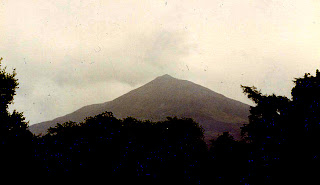Back in the year 2000, I was driving south to England from Selkirk, early morning, to be in Lichfield for 9.30am.
From Hawick I took the A6088 towards Bonchester Bridge, and as the road took a turn east just after Kirkton, I was stunned by the hill silhouetted by the early dawn light:

On the way back later that day, I took another photo of the same hill:

I confirmed this hill to be Rubers Law, O.S grid reference: NT 579 155.
I had been working on some geometry, see previous Schiehallion - Eildon line post, and was discovering the landscape of the Borders as I went. Rubers Law was part of the discovery process. I can't quite describe the feeling of shocked awe when I turned east that morning to see the hill in the dawn light, dark and brooding in silhouette. I had to check the maps to see if and where it fitted in. With great amazement I found it to be in a direct line with Schiehallion and Galachlaw, the entre of the original pentagonal system previously described. Especially so since I had already confirmed the Schiehallion -Arthurs Seat - Eildon line.
When I got round to doing the detailed calculations, I was even more amazed to find that Galachlaw was indeed very close to the Phi-point.
A few calculations to show this:
Grid References (full, and normal forms)):
2713.83 7547.74 Schiehallion summit NN 714 547
3253.65 6683.21 Galachlaw cairn NT 253 683
3249.37 6687.44 Water Works mast( exact Phi-point) NT 249 686
3580.35 6155.75 Rubers Law summit NT 579 155
Schiehallion:
 first calculation; Schiehallion - Rubers Law:
first calculation; Schiehallion - Rubers Law:2713.83 7547.74 Schiehallion
3580.35 6155.75 Rubers Law
--------- ----------
0866.52 1391.99
By Pythagoras' theorem;
1639.66which converts to
101.88 miles(E), and
90.87 miles(S)The angle to grid north is
31.9024 degrees, using the tangent of the two calculated values above.
Second Calculation; Schiehallion - Galachlaw cairn:2713.83 7547.74 Schiehallion
3253.65 6683.21 Galachlaw cairn
--------- ----------
0539.82 0864.53
By Pythag. 1018.22
which converts to
63.33miles(E)and
56.48miles(S)angle to grid;
31.98075 deg.using the English miles distances of both we ind the relationship to be 99.424% of Phi:
101.88/63.33 = 1.60872, which is 99.424% of 1.618034.
Galahlaw Cairn:

The exact Phi-point proves to be some 660 yards to the north west of the cairn, at point (3249.37 6687.44), which is in the Water works where a Mast is erected, normal grid reference NT 249 686.
view of gap between Hillend fort on right and Galachlaw with Water Works Mast to the left:

This mast can be seen to the left of this photo, with Hillend Fort to the right.
Comment:All I can say about this is that it was around this time that I came to strongly accept a 'sense of process' involving time and place, and which I for sure am not in control of. It is not just an excuse for me to be lazy in presenting all this material, it has taken years to get to, and I have learned to accept patience as an essential. All the geometry and correlations have in a sense been presented as and when 'this process' deems necessary. I no longer question this, it just happens when it does.
supplementaryWhen plotting this line on Google Maps, I checked Fordell Castle which I had noted originally was on this line, and on calculation was found to be at the centre, Fordell Hill precisely, within the estate. Fordell was the home/seat of Nicholas 'Nicky' Fairbairn, a Tory MP, government Minister and somewhat extrovert.
As Galachlaw is at the phi-point of the line, there is another equivalent on the other side of the centre-point. On examination and confirmed by calculation, it was found to be White, or Hood Hill, NO 042 018, near Tullibole Castle, by Crook of Devon.
There is also a radio/electronics mast on Hood Hill!? (Once is chance, twice is coincidence...!)
(There was reported that a sign-post in Crook Of Devon had neatly printed under it: 'Twinned with Thief Of Baghdad'! - btw! lol)
In addition it was noted that Lauriston Castle is on this line, and Cramond Island. Lauriston Castle came to my attention in connection with John Napier of Merchiston, an Alexander Napier having owned it. Lauriston Castle proved subsequently to be a geometric node, and still to be described.
Cramond has been highlighted recently by Bill Buehler, in connection with the Roman lion staue with man in its mouth, which I also linked with John Napier, or the double lion-gate at Merchiston, in an e-mail exchange!


